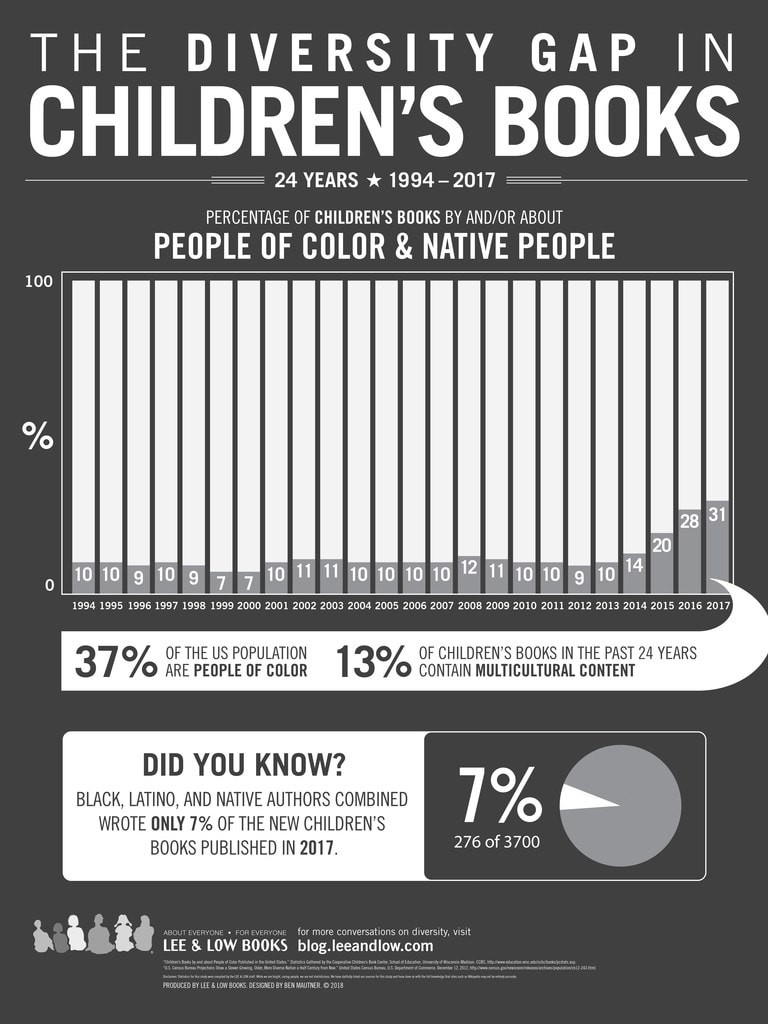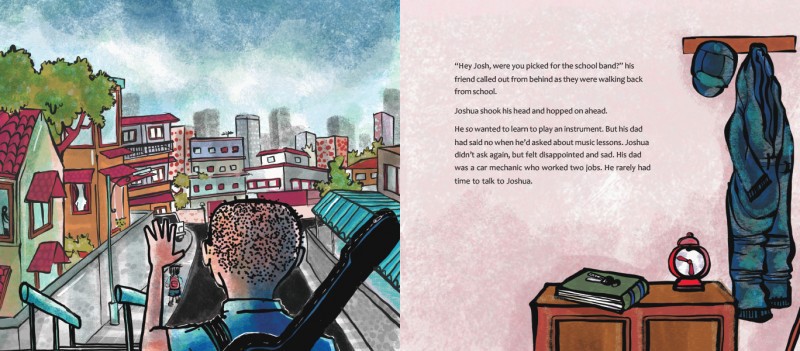Only one in every 100 children’s books features a main character from a black, Asian or other minority ethnic background, a study commissioned by the Centre for Literacy in Primary Education, UK in 2017 revealed. The study reviewed 9,115 books published for children in the year and found the collection wanting.
In 2017, Lee and Low Books, USA shared this infographic.
 In India, we are yet to commission studies of this kind but as library educators we aim to continue to be open and critical to possibilities of under representation and mis representation in this fast growing industry.
In India, we are yet to commission studies of this kind but as library educators we aim to continue to be open and critical to possibilities of under representation and mis representation in this fast growing industry.
We use this space to bring out an aspect around representation that bears reflection and use the text Music for Joshua by Chatura Rao, Illustrated by Satwik Gade and published by Tulika as a case in point.
Joanne , a library educator based in Chennai writes “I picked up the copy of Music for Joshua when I visited the Tulika Bookstore two weeks ago.
It was rare to see a Christian name on an Indian picture book, in fact I cannot recall if I have ever come across one before.”
And this statement was close to the reaction that we experienced in Goa as well. Deepali wrote, “ I was naturally curious when I read the title of this book. At least I cannot recall reading an Indian picture book which has a Catholic named character.” Joshua on the cover of the book ! How wonderful because this name abounds in our cultural context and immediately felt warm and familiar.
I flipped the book around and read “ From the award-winning author of Gone Grandmother comes another endearing story that takes us into the heart of a family from the small East Indian community of Mumbai. Against a hazy skyline of high-rises, amidst monsoon skies, the buoyant pictures zoom in on colourful old buildings, trellised balconies, sloping roofs and cobbled alleys to bring us the ambience of a typical ‘gaothan’ “
Along came an East Indian and I imagined I was offering her a gift. “Here” Lalita I said, “a book about your community. Read it and tell me what you think. “
A day later, Lalita writes,”The first thing that struck me was if it was truly an EI ( East Indian) story why was there no mention of an EI strong hold like Vasai, Bandra, Kotachiwadi, Malad? I read on and followed Joshua’s journey as he shadowed the music teacher from home to home possibly in a small bylane in Mobai (EI Marathi word for Mumbai) in the hope that he would be able to learn the guitar – something he longed to learn but was denied by his father. As I go on I come to a part in the story where a popular Konkani song ‘ Tuza Mog’ is being sung….well maybe Joshua has one parent who is Goan and the other an East Indian. The more popular East Indian Marathi songs like ‘Galyan Sankli Sonaychi’ and ‘Sakalche Para’ would be belted out by any true blue East Indian family! The East Indian community though not proud in nature would not live in chawls unless economic conditions forced them to do so but in gaothans and small fishing villages along the Mobai coast. “
There was a sense of a mix-up here. Is this story trying to represent the East Indian community ? I took the text back to Joanne, and she wrote “ Chawls are residences built in the mill areas of Mumbai, which were primarily used by the immigrants from other states who came to Mumbai looking for jobs. They are definitely not part of the gaothans which are traditional ‘villages’ of the East Indians.If there are East Indians in chawls this is a more recent phenomenon and they may have moved there for various reasons, maybe financial or maybe as a result of a family dispute. But does the ‘chawl’ capture the East Indian living condition ? Absolutely not “
Not wanting to get stuck in only one dimension of representation of the book, I shared the book with Anandita. Anandita is Christian, has a music loving, performing father and understands what it is to be a minority from living in a big metro city before coming to Goa. So, I waited, I hoped she would add a refreshment to this text that was trying to do something no one else has done in mainstream India for the EI community in children’s books – represent the under- represented, represent a minority group.
Anandita wrote, “After I read the book, I did not quite connect or feel any empathy with the character or the story to any extent and read it once again to see if I had missed some details in the story or the illustrations. The story is simple and typical, unfolding the story of young Joshua, who would have loved to learn the guitar but does not have the means to do so. As the story proceeds, the ending fulfills Joshua’s wish, in a way that keeps his family happy and included too. The illustrations while colorful, were stereotypical in some aspects, and disproportionate in others, to the East Indian Community who the story is supposed to have represented. Overall, I did not find that the book brought anything fresh or anything of depth to the reader. “ Ah Yes, that particularly Indian way we have of addressing teachers, Mattew Sir, ____Miss made the text familiar but the fact that most characters have Christian names was not lost on any of us. A quick count of the four Christians on this review discussion found that only one had a Christian name, so we wondered if naming in the book is also stereotypical in an unknowing way ?
Ah Yes, that particularly Indian way we have of addressing teachers, Mattew Sir, ____Miss made the text familiar but the fact that most characters have Christian names was not lost on any of us. A quick count of the four Christians on this review discussion found that only one had a Christian name, so we wondered if naming in the book is also stereotypical in an unknowing way ?
It does seem dreadfully intense of us to be examining this book so closely, but it must be remembered that each of us identified with the title and the blurb imagining we were being included and then read on to question that very aspect of this inclusion.
Representation is not only about being re – presented it is very much about the how and the quality of that re – presentation which brings me to the plot.
If we look at the aspect of minority representation the plot is problematic. It rides on a familiar formular of inaccess – to access and in this case driven by unstated economic difficulties in Joshua’s family. Does a minority theme emerge only on a platform of suffering ? Is this one of the only dimensions that enable writing to be received by the dominant groups ? Are there other dimensions of minority groups that can be celebrated without the need to exoticise, or pity?
At the moment, every book that chooses to re – present a minority group carries a heavy weight and becomes open to our critical thinking. It is what we need to do in library education as we examine books for our collections. The book has to fulfil so many expectations which may seem unreasonable at this time when the production volumes around minority themes are so few. We hope that if the volume published with thought, attention and to honor representation increases there will be an opportunity for wider experiences to be shared and reflected. Until then we ask for more attention, more thinking, more discernment and we await for such titles in our libraries everywhere to spread book joy!
_________________
The writers are all library educators nurtured by the LEC ( Library Educator’s Course ) offered by Bookworm, Goa and supported by Parag ( an initiative of the Tata Trusts).

This is an amazing example of a combined review which includes readers who have reason to feel connected with the text and the characters, who have first-hand knowledge of the community and location highlighted in the story and who are discerning. The result is an honest assessment of the book as a whole. What comes out so clearly is the promise of the book and the reality. How can we encourage or facilitate reviews like this one which begins with a keen and unbiased anticipation of the book, continues with close interaction and completes the circle with an in-depth review?
Thank you Bookworm team.Reading this was an education for me.